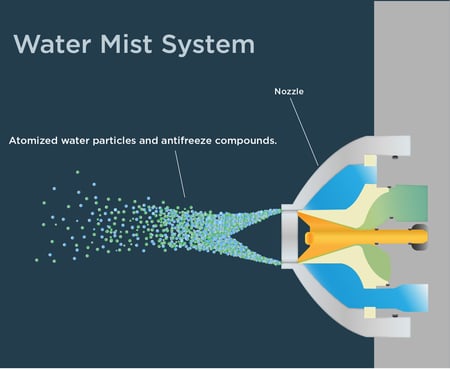Fire suppression systems may utilize a range of different fire suppression chemicals, or agents, to suppress a fire when they are activated. Firetrace International offers a choice of agents, allowing design flexibility for different applications. One agent we don’t offer is water mist; this post explains why not.
Water mist formulations are being marketed as fire suppression agents that are cleaner and more environmentally-friendly than dry chemicals, such as Purple K. However, while water is benign, water mist suppression agents also contain chemical additives. These additives, including aqueous film-forming foam (AFFF), ethanediol (ethylene glycol), and other types of antifreeze, are corrosive, flammable, and harmful to drinking water and aquatic life. Moreover, some additives cause water mist suppression systems to form a film on the equipment they protect, if they are activated and discharged. This film can be challenging to remove, especially if the enclosure has lots of crevices and compartments.
Common water mist additives
AFFF Foam – An additive that contains compounds known to contaminate drinking water. AFFF has known corrosive and environmental concerns, according to the Naval Research Laboratory.
Antifreeze – A water mist system is only able to function in cold temperatures when chemicals are added to reduce the freezing point. These chemicals are necessary for water-mist systems, but many have toxic and/or corrosive properties.
Ethanediol – Ethanediol, also known as ethylene glycol, is a toxic additive that is used to lower the freezing point of the water-mist solution. Exposure to ethanediol can cause damage to the central nervous system, heart, and kidneys. For those involved with deicing equipment, this chemical is familiar. It is a combustible compound used in the deicing process at airports around the world. When a water-mist solution is used to put out a fire in a deicer, you could be spraying the exact chemical that was the cause of the fire.
Potassium Formate and Potassium Acetate – corrosive compounds that have been linked to carbon brake oxidation, cadmium corrosion, and damage to runway lights, GSE, and runway pavement. These compounds can make up to 45% of a water mist solution.
Corrosiveness
Water itself is as neutral as it gets, however when AFFF is added, it is a different story. Three percent AFFF solution becomes highly corrosive when it interacts with metal. The chemical must be removed with high-pressure water to prevent equipment damage, which can start within hours. Pressure washers are not common in many operations and the process to remove all remains of water mist is messy and difficult.
Freezing point
The main concern with water mist is the suppression agent can’t be used in cold environments without a large concentration of antifreeze, notably ethanediol. With outdoor environments reaching temperatures much lower than 32 degrees F, the fire suppression agent will freeze without these corrosive additives. When deployed, the water mist system delivers these harmful additives to high-value assets.
Environmental and health concerns
The Federal Aviation Administration (FAA) recognizes the growing concern of using AFFF and is nudging airport facilities to switch to less effective fluorine-free versions. However, even fluorine-free foams are harmful to drinking water and aquatic life because of the high oxygen-demand of the chemical and acute toxicity, according to the ITRC.
Recommendations
Firetrace offers an array of fire suppression agents to effectively protect equipment from fires. An example is Purple K dry chemical, which is one of the agents we recommend for vehicle fire suppression systems. Compared with water mist, Purple K can be used in a wider range of temperatures, is highly effective at suppressing Class B and Class C fires, and does not pose environmental risk.

